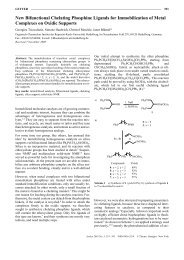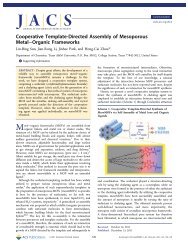Singlet Fission - Department of Chemistry
Singlet Fission - Department of Chemistry
Singlet Fission - Department of Chemistry
You also want an ePaper? Increase the reach of your titles
YUMPU automatically turns print PDFs into web optimized ePapers that Google loves.
J Chemical Reviews, XXXX, Vol. xxx, No. xx Smith and Michl<br />
Figure 8. Jablonski diagram for singlet states <strong>of</strong> chromophores<br />
<strong>of</strong> classes I-III, with the most common mode <strong>of</strong> population <strong>of</strong> the<br />
S1 state shown (in rare cases <strong>of</strong> chromophores <strong>of</strong> classes II and III,<br />
the h f l excited state might be S3 or even higher).<br />
fission. 57,58 The procedure is also simple when there are only<br />
two chromophores, A and B, and we will discuss this case<br />
in some detail. To organize the material, we shall adopt a<br />
simple model that has been used with small variations many<br />
times before for many purposes (only a few examples are<br />
listed 57-62 ). It was also used in a recent study <strong>of</strong> singlet fission<br />
in which the time evolution <strong>of</strong> the S1 A S0 B state under the<br />
effect <strong>of</strong> the one-electron part <strong>of</strong> Hint alone was followed. 33<br />
By analogy to the cases <strong>of</strong> singlet and triplet energy<br />
transfer, 62 in which this type <strong>of</strong> term dominates, this may be<br />
an acceptable approximation.<br />
In the model, the eigenstates <strong>of</strong> Hel A and Hel B are approximated<br />
by single configurations built from Hartree-<br />
Fock MOs <strong>of</strong> the chromophores A and B, respectively. The<br />
MOs on A and B are assumed to be mutually Löwdin<br />
orthogonalized, and the orthogonalization is assumed to have<br />
almost fully preserved the localization. A further simplification<br />
is introduced by limiting the MOs to hA and lA on A<br />
and hB and lB on B. In spite <strong>of</strong> these drastic assumptions,<br />
the model captures the fundamental physics <strong>of</strong> the most<br />
important two <strong>of</strong> the three main classes <strong>of</strong> π-electron<br />
chromophores, which include almost all <strong>of</strong> those that have<br />
been <strong>of</strong> interest in studies <strong>of</strong> singlet fission. We refer to these<br />
chromophore classes as classes I, II, and III (Figure 8).<br />
Our purpose is to organize the material and provide<br />
qualitative insight into the terms that need to be considered<br />
when contemplating the origins <strong>of</strong> structural dependence <strong>of</strong><br />
the frequency factor A[S1S0 f 1 (TT)]. For the purposes <strong>of</strong><br />
an actual calculation, more rigor would be needed. In<br />
particular, it would undoubtedly be necessary to treat overlap<br />
in a manner similar to the now standard treatment <strong>of</strong> energy<br />
transfer. 62 This would involve an initial diagonalization <strong>of</strong> a<br />
subspace that contains local and charge transfer excitations<br />
and dealing with overlap explicitly. Although such a<br />
formulation appears quite straightforward, it has not yet been<br />
published for singlet fission, and we will not use it here.<br />
Chromophores <strong>of</strong> Class I. This class comprises those π<br />
chromophores whose first excited singlet state S1 is reasonably<br />
described as a result <strong>of</strong> an h f l (HOMO to LUMO)<br />
electron promotion from the ground state and is separated<br />
from the next higher singlet S2 by a significant energy gap.<br />
Class I chromophores are exemplified by anthracene (1),<br />
tetracene (2), perylene (9), and 1,3-diphenylisobenz<strong>of</strong>uran<br />
(8). In compounds formally derived from a (4N + 2)-electron<br />
perimeter, such as these, the S0 f S1 transition terminates<br />
in Platt 63 and M<strong>of</strong>fitt’s 64 La state, carries considerable<br />
oscillator strength, and represents the usual point <strong>of</strong> entry<br />
into the excited singlet manifold when the ground state<br />
absorbs light. In the less common chromophores derived<br />
from a 4N-electron perimeter, the h f l transition has low<br />
intensity and is <strong>of</strong>ten symmetry forbidden. 65,66 However, to<br />
our knowledge, no such chromophores have been examined<br />
for singlet fission.<br />
Chromophores <strong>of</strong> Class II. In the less numerous chromophores<br />
<strong>of</strong> class II, the strongly allowed h f l excitation<br />
leads to the S2 state and still represents the usual entry point<br />
into the excited singlet manifold by absorption <strong>of</strong> light. The<br />
S1 state, which is <strong>of</strong>ten only slightly lower in energy and is<br />
reached from the higher singlet states by fast internal<br />
conversion, is quite well described as arising from an out<strong>of</strong>-phase<br />
combination <strong>of</strong> h - 1 f l and h f l + 1 electron<br />
promotions from the ground state, where h - 1 is the next<br />
MO below h and l + 1 is the next MO above l in energy. Its<br />
perimeter model label is Lb, and it carries low oscillator<br />
strength. Typical examples <strong>of</strong> class II chromophores are those<br />
in which the energy difference between the MOs h and h -<br />
1 and that between the MOs l and l + 1 are small. Benzene,<br />
where the degeneracy <strong>of</strong> the h and h - 1 and <strong>of</strong> the l and l<br />
+ 1 MOs is exact, making the description a little more<br />
complicated, is the best known case. Others are naphthalene,<br />
phenanthrene, and pyrene (12). Since the simple model<br />
adopted for our discussion does not include the MOs h - 1<br />
and l + 1, it is incapable <strong>of</strong> describing the properties <strong>of</strong> the<br />
S1 state <strong>of</strong> chromophores <strong>of</strong> class II. The required generalization<br />
is straightforward, but very little work has been done<br />
on singlet fission involving chromophores <strong>of</strong> this class, and<br />
we will not generalize the model here.<br />
Chromophores <strong>of</strong> Class III. Similarly as in chromophores<br />
<strong>of</strong> class II, in chromophores <strong>of</strong> class III the strongly allowed<br />
h f l excitation provides a good description <strong>of</strong> the nature<br />
<strong>of</strong> the lowest excited state carrying a large oscillator strength<br />
from the ground state (usually the S2 state), and again<br />
represents a typical entry point into the excited singlet<br />
manifold by absorption <strong>of</strong> light. Now, however, the S1 state,<br />
which is usually only slightly lower in energy and can again<br />
be reached from the higher singlets by fast internal conversion,<br />
contains a large weight <strong>of</strong> a configuration in which both<br />
electrons that occupy h in the ground state have been<br />
promoted, h,h f l,l. Although commonly used, the usual<br />
designation “doubly excited state” is <strong>of</strong>ten quite inaccurate<br />
because the description <strong>of</strong> this S1 state may also contain large<br />
contributions from additional singly excited configurations,<br />
especially h - 1 f l and h f l + 1. Our model permits a<br />
description <strong>of</strong> the doubly excited configuration, but not <strong>of</strong><br />
these additional configurations. The results will therefore be<br />
even less accurate than those for chromophores <strong>of</strong> class I.<br />
An alternative description <strong>of</strong> the doubly excited singlet state<br />
is as two local triplet excitations intramolecularly coupled<br />
into an overall singlet (e.g., in butadiene, it corresponds to<br />
a singlet coupled pair <strong>of</strong> local triplets, one on each<br />
ethylene 9-11 ).<br />
The best known examples <strong>of</strong> chromophores <strong>of</strong> class III<br />
are polyenes and related linearly conjugated polymers, but<br />
very recently it has been proposed on the basis <strong>of</strong> ab initio<br />
calculations 40 that pentacene (3)issimilarinthatitsS1 state,<br />
which is <strong>of</strong> the h f l type, and its S2 state, which is <strong>of</strong> the<br />
h,h f l,l type, are calculated to be almost exactly degenerate.<br />
The well studied absorption and fluorescence spectra <strong>of</strong><br />
isolated molecules exclude the possibility that the doubly



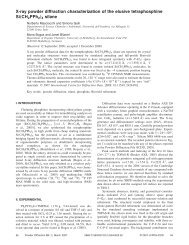

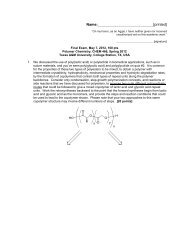

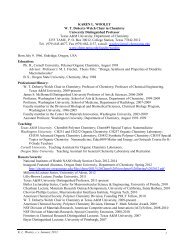
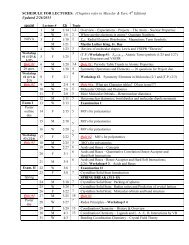
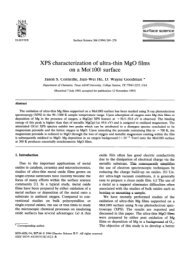
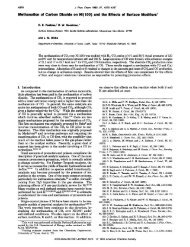
![Radical salts of TTF derivatives with the metal–metal bonded [Re2Cl8]](https://img.yumpu.com/10115211/1/190x253/radical-salts-of-ttf-derivatives-with-the-metal-metal-bonded-re2cl8.jpg?quality=85)



